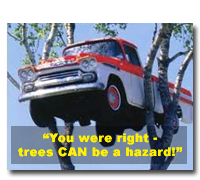
05 Sep, 2012
The most confusing part of the Theory Test for pupils appears to be the Hazard Perception section. It's certainly what we get asked about most of the time
by learners.
The reason for this is because it isn't completely clear to most pupils what 'Hazard Perception' means. On the other hand, It's pretty easy to
work out what a 'multiple choice Theory Test' is!
So, to clear up any confusion, let's split up the words. In reference to driving, most learners will have a fair idea what a hazard is - a pedestrian
crossing the road, snow and ice on the road, a very sharp bend, a level crossing etc. These are all explanations we've been given
by our pupils on hazards, and they are of course, correct.
However, there are any number of objects, events and situations that can create a hazard, so we need to look at the explanation by the DSA to
get a more accurate translation.
A hazard is anything that causes a driver to slow down or change direction. Therefore, we can safely say that a driver encounters
hazards on every road that he drives.
To understand this, a learner needs to think about situations which cause them to slow down - a junction, a bend, a pedestrian
crossing, approaching stationary traffic, heavy rain, a roundabout, crossroads, roadworks, near a school etc. I'm sure you can think of many more.
The learner also needs to think about situations which cause them to change direction - passing a cyclist, a bend, a junction, a roundabout,
passing stationary vehicles etc. again, I'm sure you have more to add to the list.
You've probably noticed that many of these situations can be combined e.g. at a junction or on a bend the driver will probably have to slow down
and change direction.
Now that we have a grasp of what the DSA considers a 'Hazard' to be, lets look at the word that confuses most pupils - 'Perception'.
What does 'Perception' mean? Well, in relation to driving and how the DSA interpret it, it means - a driver being aware of an event that is
about to happen.
Now, it would be ridiculous for a driver to be paying attention to everything happening around him whilst concentrating on
the job of driving. So we can narrow it down to events that are about to happen - on the route the driver is taking.
Using an example of someone crossing the road, the driver must stay aware of what is happening in front of the the vehicle, so when the pedestrian
steps into the road, a good driver has already slowed down because they were aware and anticipated the situation.
The word anticipation nicely sums up the core skill required for Hazard Perception.
Because it would be dangerous for drivers to constantly slow down and/or change direction as a result of every event on the road,
they pay particular attention to hazards that are developing into a situation that they can't avoid. Essentially,
the most important hazards are developing hazards.
Visual explanation of Hazard Perception test
So, when driving along on the road (or watching the video clip in the Hazard Perception test), we're looking at what's happening ahead,
but paying particular attention to any events that look like they may start to effect what we plan to do.
The good example is a car on a side road approaching the road we are travelling on. We must stay aware of it because it could easily develop into a
hazard.
It's not a hazard if the other driver slows down and stops as they should. It is a hazard if the
other driver approaches too quickly and stops halfway into the road we are travelling on.
This is where our perception is tested!! As a driver, we should be aware that the other vehicle is approaching too quickly.
In summary, a driver slows down and/or changes direction as a hazard develops - this shows they anticipated the hazard. In the
Hazard Perception test, a candidate clicks the mouse to show they anticipated the hazard.
Visual explanation of Hazard Perception test

